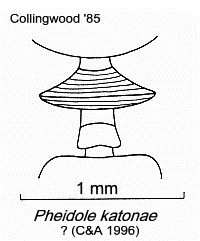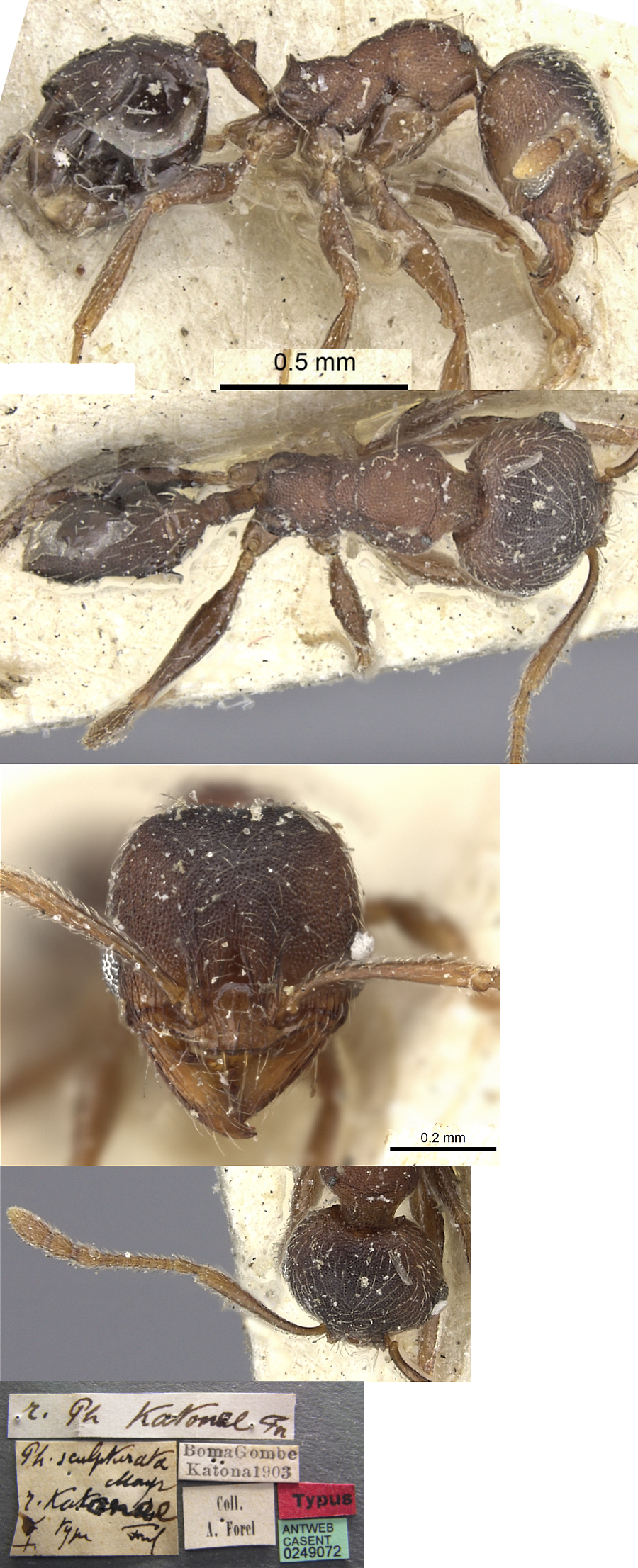Pheidole katonae Forel
  Type location Tanzania
(Pheidole sculpturata Mayr subsp. Katonae n. subsp.,
Forel, 1907a: 21, minor - see below; Menozzi & Consani, 1952: 62,
major - not
listed in Bolton, 1995; nor by Collingwood, 1985, Collingwood &
Agosti, 1996); major (?) and minor workers described Type location Tanzania
(Pheidole sculpturata Mayr subsp. Katonae n. subsp.,
Forel, 1907a: 21, minor - see below; Menozzi & Consani, 1952: 62,
major - not
listed in Bolton, 1995; nor by Collingwood, 1985, Collingwood &
Agosti, 1996); major (?) and minor workers described  . .
|
Forel's
(1907a) description is at  . Menozzi & Consani's (1952)
description of the major is at . Menozzi & Consani's (1952)
description of the major is at  . .
Note: Given the
small size of the type worker, TL 2.2 mm (Forel, 1907a), the supposed
major described by Menozzi & Consani (1952) as TL 8.7-9.0 mm, HW =
HL = 3 mm, is almost certainly not the major of katonae.
The type minor, however, appears identical to that of Pheidole bequaerti Forel
1913b. If so, this would be the senior synonym. The major of P. bequaerti has TL 2.5 mm, HL
1.15, HW 1.09, SL 0.59, PW 0.50; CI 96, SI 54.
|
 Collingwood
(1985), describing specimens from Saudi
Arabia,
provided the illustration, right, of the pedicel dorsum. He noted
postpetiole wider than long, distinctly dentate at widest point,
promesonotal outline broken by a distinct mesonotal ridge, funiculus
segments 2, 3 & 4 longer than broad; specimens with major HW 2.2 -
3.0 mm; large heads slightly longer than wide, clear red with
longitudinal striae fading out on the occiput. Found nesting under a
stone and as individual foragers. Later, Collingwood & Agosti
(1996) separated katonae as a separate species, in which the
appendages have decumbent pubescence and the head sculpturation is weak
and stated the earlier reference to Pheidole sculpturata was an
error. While Collingwood & Agosti probably associated the majors
with the Menozzi &
Consani "katonae",
to which the dimensions match, it is unlikely that the type is known
from Saudi Arabia. It may well match those I, too, thought might be but
now recognise as Pheidole ruspolii from Ethiopia. Collingwood
(1985), describing specimens from Saudi
Arabia,
provided the illustration, right, of the pedicel dorsum. He noted
postpetiole wider than long, distinctly dentate at widest point,
promesonotal outline broken by a distinct mesonotal ridge, funiculus
segments 2, 3 & 4 longer than broad; specimens with major HW 2.2 -
3.0 mm; large heads slightly longer than wide, clear red with
longitudinal striae fading out on the occiput. Found nesting under a
stone and as individual foragers. Later, Collingwood & Agosti
(1996) separated katonae as a separate species, in which the
appendages have decumbent pubescence and the head sculpturation is weak
and stated the earlier reference to Pheidole sculpturata was an
error. While Collingwood & Agosti probably associated the majors
with the Menozzi &
Consani "katonae",
to which the dimensions match, it is unlikely that the type is known
from Saudi Arabia. It may well match those I, too, thought might be but
now recognise as Pheidole ruspolii from Ethiopia.
|
 The
photomontage is of the type minor worker collated
from http://www.antweb.org/specimen.do?name=casent0249072 The
photomontage is of the type minor worker collated
from http://www.antweb.org/specimen.do?name=casent0249072
|
|